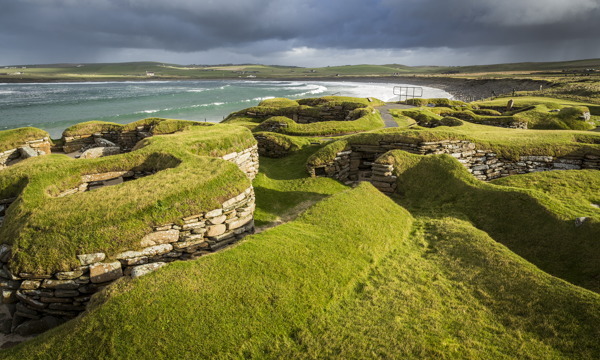Leading climate scientists and heritage professionals from across the globe are gathering in Orkney for a major workshop to apply a new tool for measuring the climate change threat to World Heritage sites.
Supported by Historic Environment Scotland (HES), in partnership with University of the Highlands and Islands, James Cook University (JCU, Australia), Orkney Islands Council and the Union of Concerned Scientists (UCS), the workshop in Stromness will pilot the new methodology which assesses the risks to all types of heritage sites impacted by climate change, known as the Climate Change Vulnerability Index (CVI).
The Heart of Neolithic Orkney will be the first cultural World Heritage site to undergo CVI assessment, following an initial trial of the tool over 8000 miles away at Shark Bay in Western Australia – a natural site which encompasses 2.2 million hectares of diverse landscapes, animals and plant life.
As part of the CVI workshop, delegates will visit the historic sites that comprise the Heart of Neolithic Orkney World Heritage site, including Skara Brae and the Ring of Brodgar. Several delegates will also speak at a public event at Orkney College UHI in Kirkwall on the evening of Thursday 25 April, which will offer the local community an opportunity to find out more about the project and the challenges of managing the World Heritage site in changing climate.
Following the workshop, a report will be produced and then presented during the 43rd session of the World Heritage Committee which takes place in Baku, Azerbaijan this July, highlighting the results from Orkney and recommending that the CVI be adopted as a world standard for measuring the climate change risk to World Heritage sites.
Ewan Hyslop, Head of Technical Research and Science at HES, said:
Climate change poses a number of very real threats to heritage sites, not only here in Scotland but throughout the world.
"We’re very pleased to have been asked by the International Council on Monuments and Sites (ICOMOS) Climate Change and Heritage Working Group to pilot the CVI assessment tool in Orkney.
“At HES, we’ve already undertaken significant work to research the climate change risk our historic sites face, as outlined in our Climate Change Risk Assessment report which was published last year. This workshop offers an important opportunity to further enhance our knowledge and pool expertise by working collaboratively with our local, national and international partners to face this shared challenge, and take a positive step forward to help protect World Heritage sites across the globe.”
Dr Scott Heron, Senior Lecturer in Physics at JCU and one of the lead developers of the CVI assessment tool, said:
Climate change has been identified as the fastest growing threat to World Heritage properties, many of which are already being impacted.
"The purpose of this workshop is to assess the climate vulnerability of the Orkney World Heritage site, using a tool custom designed for application to all types of World Heritage properties - cultural and natural, marine and terrestrial."
Adam Markham, Deputy Director for Climate and Energy at the Union of Concerned Scientists, and a member of the ICOMOS working group, said:
“UCS has been at the forefront of identifying the growing threat to World Heritage sites from climate impacts including from sea level rise, extreme weather events, coastal erosion and worsening storm surge.
From the Statue of Liberty in New York, to Saint Mark’s Basilica in Venice, iconic heritage sites the world-over are at risk.
“We’re excited to be working with HES and the other partners to pioneer the development of this urgently needed rapid assessment tool to help prioritise and plan climate resilience actions at internationally important sites.”
Professor Jane Downes, who leads the University of the Highlands and Islands Institute of Archaeology, said:
Our research shows that Orkney’s world class heritage is suffering greatly from the impacts of climate change.
“We welcome this work as a vital part of setting Orkney’s heritage in today’s global context, while planning for the long term.”
Find out more about how climate change affects the historic environment and what HES is doing to help limit the impact or have your say on our draft Climate Change and Environmental Action Plan (CCEAP) 2019-24.
About Historic Environment Scotland (HES)
- We are the lead public body charged with caring for, protecting and promoting the historic environment. We will lead on delivering Scotland’s first strategy for the historic environment, Our Place in Time.
- Historic Scotland, Scran, Canmore, The National Collection of Aerial Photography (NCAP), The Engine Shed, Stirling Castle and Edinburgh Castle are sub-brands of HES.
- View our press pack and keep up to date by registering for media release email alerts. If you wish to unsubscribe, please contact us.
Follow Historic Environment Scotland
Twitter: @HistEnvScot | @welovehistory
Facebook: @HistoricEnvScotland | @VisitHistoricScotland
Instagram: @HistEnvScot | @historicscotland
For further information, please contact:
Claire Mullaney
Historic Environment Scotland Media Office
Direct line: 0131 668 8588
Mobile: 07881 512 379
communications@hes.scot

